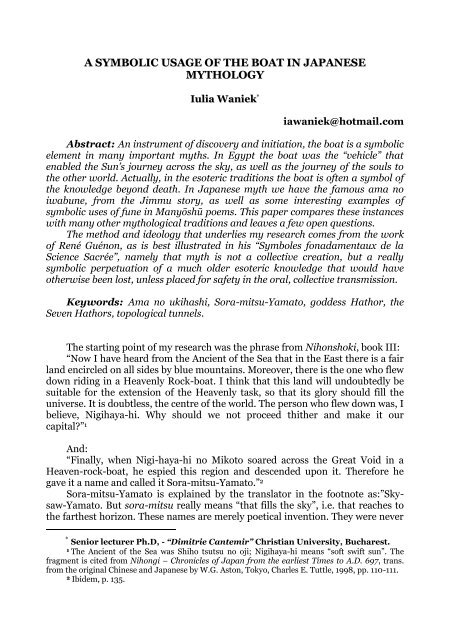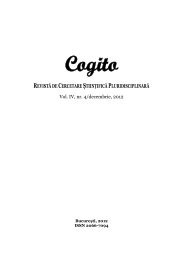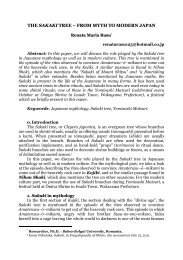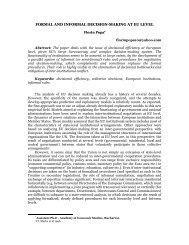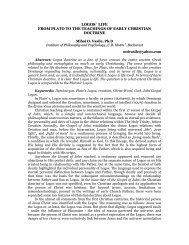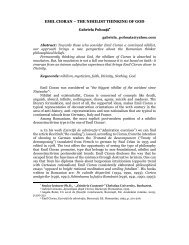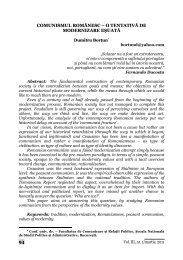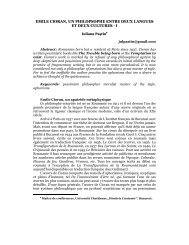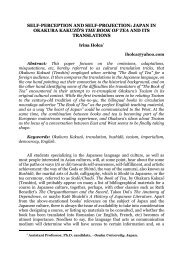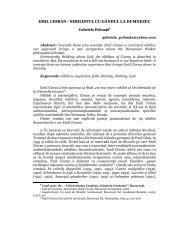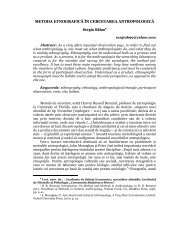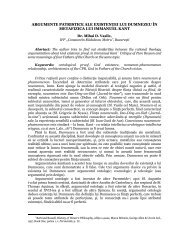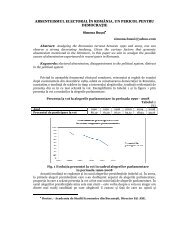A SYMBOLIC USAGE OF THE BOAT IN JAPANESE MYTHOLOGY
A SYMBOLIC USAGE OF THE BOAT IN JAPANESE MYTHOLOGY
A SYMBOLIC USAGE OF THE BOAT IN JAPANESE MYTHOLOGY
You also want an ePaper? Increase the reach of your titles
YUMPU automatically turns print PDFs into web optimized ePapers that Google loves.
A <strong>SYMBOLIC</strong> <strong>USAGE</strong> <strong>OF</strong> <strong>THE</strong> <strong>BOAT</strong> <strong>IN</strong> <strong>JAPANESE</strong><strong>MYTHOLOGY</strong>Iulia Waniek iawaniek@hotmail.comAbstract: An instrument of discovery and initiation, the boat is a symbolicelement in many important myths. In Egypt the boat was the “vehicle” thatenabled the Sun’s journey across the sky, as well as the journey of the souls tothe other world. Actually, in the esoteric traditions the boat is often a symbol ofthe knowledge beyond death. In Japanese myth we have the famous ama noiwabune, from the Jimmu story, as well as some interesting examples ofsymbolic uses of fune in Manyōshū poems. This paper compares these instanceswith many other mythological traditions and leaves a few open questions.The method and ideology that underlies my research comes from the workof René Guénon, as is best illustrated in his “Symboles fonadamentaux de laScience Sacrée”, namely that myth is not a collective creation, but a reallysymbolic perpetuation of a much older esoteric knowledge that would haveotherwise been lost, unless placed for safety in the oral, collective transmission.Keywords: Ama no ukihashi, Sora-mitsu-Yamato, goddess Hathor, theSeven Hathors, topological tunnels.The starting point of my research was the phrase from Nihonshoki, book III:“Now I have heard from the Ancient of the Sea that in the East there is a fairland encircled on all sides by blue mountains. Moreover, there is the one who flewdown riding in a Heavenly Rock-boat. I think that this land will undoubtedly besuitable for the extension of the Heavenly task, so that its glory should fill theuniverse. It is doubtless, the centre of the world. The person who flew down was, Ibelieve, Nigihaya-hi. Why should we not proceed thither and make it ourcapital?” 1And:“Finally, when Nigi-haya-hi no Mikoto soared across the Great Void in aHeaven-rock-boat, he espied this region and descended upon it. Therefore hegave it a name and called it Sora-mitsu-Yamato.” 2Sora-mitsu-Yamato is explained by the translator in the footnote as:”Skysaw-Yamato.But sora-mitsu really means “that fills the sky”, i.e. that reaches tothe farthest horizon. These names are merely poetical invention. They were never Senior lecturer Ph.D, - “Dimitrie Cantemir” Christian University, Bucharest.1The Ancient of the Sea was Shiho tsutsu no oji; Nigihaya-hi means “soft swift sun”. Thefragment is cited from Nihongi – Chronicles of Japan from the earliest Times to A.D. 697, trans.from the original Chinese and Japanese by W.G. Aston, Tokyo, Charles E. Tuttle, 1998, pp. 110-111.2Ibidem, p. 135.
in actual use.” W. G. Aston obviously had a big conceptual difficulty with “Yamatoseen from the sky” which is, obviously, the best rendering for Sora-mitsu-Yamatoin this context. Motoori Norinaga accepted the rendering of Sora-mitsu-Yamatoas “Yamato seen from the sky” 3 , and Ian Hideo Levy beautifully translated Soramitsu/ Yamato no kuni wa as “This land of Yamato/ seen by the gods on high” 4 .Nigihayahi no mikoto, 饒 速 日 命 , is enshrined in several shrines near Kyoto,like Hikō Jinja, Iwafune Jinja or Ishikiri Tsurugi Jinja. In Iwafune Jinja (situatedat 9-19-1, Kisaichi Katano, Osaka) Nigihayahi no mikoto is symbolized by a bigrock (12 meters high and 12 meters wide), that looks like a ship. Legend has itthat Nigihayahi no mikoto flew to the place of this shrine from Takamagahara, bythis rock ship.I had written a paper on some poems from Manyōshū and Kokinshū wherethe image of the boat has symbolic meanings that appear in European literatureas well, that support so well Bachelard’s theories of the Imaginaire, or CreativeImagination of mankind, when I discovered the flying rock boat of Nihonshoki. Iconfess this shocked me, not only for realizing how careless was my prior readingof the Nihonshoki. The idea of Jimmu Tennō’s ancestor (Nigi-haya-hi no Mikoto)flying in a boat like an Egyptian solar deity across the land of Yamato wasinteresting, but I found no comments on it in the Western scholarship. Searchingfurther, I discovered that Hirata Atsutane was the Japanese scholar thataddressed the question. Great anthropologist avant la lettre, Atsutane was deeplyinterested in the supernatural and the bizarre, sensing that there are deepermeanings to be found therein, than just the surface value. On the Ama noiwabune, or the Heavenly Rock Boat, he seems to have had the following opinion:“Ama no ukihashi was used when gods deigned to come down from Heaven. Theylet it float in the big empty sky [when they] used it, and therefore it is calledfloating bridge. … Moreover, it seems that this thing to go back and forth with,because it was like a boat riding on water, was also called Heavenly Rock Boat[Ama no iwabune].” 5So Hirata Atsutane equates the Heavenly Rock Boat with Ama no ukihashi,the Floating Bridge of Heaven.I have taken the texts of Atsutane and Iida Takesato from Historical Realityor Metaphorical Expression? by Michael Wachutka. In a note of Wachutka’sbook, Atsutane is further cited to have said in Tamadasuki: “Fune really means autensil of any kind”. A utensil – it seemed so prosaic and discouraging at first.But it turned out to be very interesting, after all.In his book Michael Wachutka discusses the two approaches to Japanesemythology: the emic one, or the inner view of Iida Takesato (1828-1900) and theetic or outside view of Karl Florentz. As far as our subject matter is concerned,Iida Takesato’s interpretations of the Ama no ukihashi are very interesting.3Marra, Michael F., The Poetics of Motoori Norinaga, Honolulu, University of Hawaii Press,2007, pp.147-151.4In his translation Ten Thousand Leaves: A Translation of the Manyōshū, Japan’s PremierAnthology of Classical Poetry, Princeton, Princeton University Press, 1981, vol. 1.5The quotation is from Michael Wachutka, Historical Reality or Metaphorical Expression?,London, Literatur Verlag Munster, Hamburg, 2001, pp. 139-140.
Iida cites many comments on this matter, from Shaku Nihongi, acompilation from late Kamakura period, where the author, Urabe Kanekata,collected all the research on Nihongi, of which the peak until then had been in theHeian period. I will quote again Iida.“Ama no ukihashi. In the Sha[ku Nihon]gi it says: “Kanekata has the opinionthat Ama no Ukihashi is Ama no Hashidate.”…….In the Tango Kuni Fudoki it issaid: ”In the N-E corner of the district of Yosa no Kōri there is Haya ishi no sato.In the sea of this village there stretches a long, big promontory. The length is2,229 jō. The width, at some points, is less than 9 jō……In former times it wascalled Ama no Hashidate. …..It is said, the land creating god, Izanagi no Mikoto,in order to go back and forth to heaven, erected a ladder. Therefore it is calledAma no hashidate [Heavenly standing ladder]. While the god was sleeping, it fellover.”And a last quote: “Furthermore, in the Harima Kuni Fudoki it is said:”In thevillage Mashike in the Kako district there is a stone bridge. One legend goes thatin the ancient times this bridge reached up to heaven. Eighty companions werecoming and going down the bridge, therefore it is called Yaso Bridge.” And Iidacommented on these fragments from Fudoki like this:”We see that this also is abridge for traffic with heaven. In the Age of Gods, bridges leading up anddown from heaven must have existed here and there.” (my underline)All these passages have in common an essential feature: they point to a directcommunication with the world of the gods, via a very material channel. They alsoshow the belief that there are certain geographical places in Japan wherecommunication with the world of Heaven is possible, by this very concretechannel of communication, the bridge or ladder. Karl Florentz interpreted, in theTylorian animist manner normal for his age, that Ame no ukihashi is theRainbow 6 , personified by the ancient Japanese. But can we still subscribe to suchinterpretations in the 21-st century, after Jung, Eliade’s theories, or if we considerthe large amount of data that we have now on hand in archaeology on ancienttechnology? I think not. In my opinion Iida’s view is a more modern andreasonable interpretationThe belief in sacred places that have the power to energize the pilgrim andhelp him connect to the core, source of his being, places so extraordinary thatthey could not have been made by just human effort, is widespread, in time andspace. The Inca and Mayan Pyramids, or Egyptian Pyramids, have benefittedfrom explanations by way of extraterrestrial help, transfer of advancedtechnologies from other worldly beings, and so on. Actually, there is a whole bulkof very uncomfortable archaeology that the current academic view of our historycannot explain. I will not touch upon it here, although my paper is nothing but aplea for accepting even such disturbing views for serious consideration.So what is the point of my research? First, I subscribe completely to HirataAtsutane’s interpretation that Ama no iwabune, a Rock Boat flying in the sky, ismore of a bridge, actually, than a boat, and that it is the same thing as Ama no6Michael Wachutka, Historical Reality or Metaphorical Expression?, Hamburg, London,Literatur Verlag Munster, 2001, p. 142.
ukihashi, the bridge that gods used to go back and forth to earth. Furthermore,strange as it may seem, I consider that Egyptian myth supports thisinterpretation.I would like to compare this idea of concrete channel of communicationbetween our world and that of the gods, that we see in Japanese mythology, withsome data from Egyptian mythology, namely, the descent of the Goddess Hathor,with, guess… a Heavenly Boat, to the land of Egypt, to bring civilization.Hathor was an important goddess in Egypt, with many attributes, “the samename [of Hathor] covering actually, the initially multiple personality of severalgods” 7 . Hathor was the goddess of the sky, in an early age considered to be thebeloved daughter of Re (the Sun) and Nut (the Sky) and mother of the solar godHorus. She had countless attributes, like being considered “the living soul oftrees”, for example, especially the sycamore, or the living embodiment of gold.She was also the patron of far off lands, like Punt or Byblos, and of the Mountainof the Dead, on the West of the Nile. At Thebes, where she was the protector ofthe dead, she acquired a plural personality, becoming the Seven Hathors, sevenfairies who ruled the human destiny, like the Greek Moiras.In the Ptolemaic period, these Seven Hathors, were associated with thegroup of the brightest 7 stars from the Constellation of Pleiades, the Greeknymphs, daughters of Apollo, that turned into stars 8 .So, a group of divine beings, called Hathors, who had come with a divineboat from the sky (maybe the constell ation of the Pleiades), went across Egypt,unfolding a civilizing mission 9 . It might seem a little fanciful, but it might be notquite so, altogether. Anyway, it makes a good parallel to the image of the godIzanagi, coming down and up between Heaven and Earth, on Ama nohashidate/ukihashi, creating what was to become the Japanese land.The images of Hathor riding in a boat with other gods, and a helmsman, are onthe walls of tombs in the Valley of Deir el Bahari or at her temple at Dendera. Herorigin as a being of the Sky, is clearly proven by her representation as a cow, for thebody of a cow with stars on it was the oldest Egyptian representation of the sky.Then, as evidence of her being loved by the people, as well as of her comingand going out of Egypt several times, there are fragments of ancient Egyptianpoems that show the joy of the people when the goddess comes back from avoyage to Nubia ( On the Return of the Goddess Hathor –Tefnut from Nubia,“Hathor has gone, at dawn, toward her house. How good it is, how good it is,when she comes back to us”) 1 0 .7The Encyclopedia of Egyptian Civilization and Art, ed. Georges Posener, Bucharest,Meridiane Publishing, 1974, p. 134.8Victor Kernbach, Dictionary of General Mythology, Bucharest, Albatros Publishing, 1983,pp. 253-254.9I quote Florin Gheorghiţă: ”This strange mythical tradition leads us to the presuppositionthat cultivated persons in Egypt knew that across their country went a “group of divine Hathors” ofcelestial origin, and knew even where these Hathors came from: the group of stars knownastronomically as the Pleiades”, in The Galactic Brilliant Ones, Bucharest, Coresi Publishing, 2009,p. `133.10Florin Gheorghiţă, The Galactic Brilliant Ones, Bucharest, Coresi Publishing, 2009, pp.133-134.
The region of Karnak, Luxor, and the Valley of Hathor (Deir el Bahari), withthe Dendera temple of Hathor, is one of the oldest places where the ancientcivilization of Egypt developed. The Temple of Dendera poses indeed manymysteries, as it contains the famous stone Zodiacal Calendar, which showspositions of the constellations some 50,000 years ago. In the basement of the oldtemple were discovered bas-reliefs that show “people holding in their hands bigelectric bulbs (!!), with a filament (fig. 83), powered by cables from an electricbattery” 1 1 . Romanian researcher Florin Gheorghiţă has an interesting hypothesisconcerning these facts. As he puts it, these enigmatic artifacts as well asmythological traditions widespread in the ancient world suggest “the descentfrom heaven, in the respective places, of some highly evolved, unknown beings,who demonstrated miraculous powers in a way beneficial to humans. …. suchtroubling remains speak of themselves: they demonstrate a fact thatarchaeologists – as the whole contemporary scientific community, actually –avoid and push back repeatedly, namely that highly evolved beings were presentthere for a long period of time.” 12This archaeological evidence of a contact with other civilizations, which wasgathered from around the world in a thick file with the label of paleoastronautics,is not the object of my paper. There is yet another interesting aspect in thehypotheses of Florin Gheorghiţă which connects well to our Ama no ukihashi, orFloating Bridge to Heaven, from Kojiki and Nihonshoki: namely the idea oftopological tunnels in which the space-time continuum is canceled, and whichappear to exist in those energetic places on Earth, where the exchange of energywith the Cosmos is intense, which were considered Sacred places (and wherecivilization first appeared). It is through such a topological tunnel, or Portal, onthe Gizeh plateau near the Sphynx, and on the Nile Valley near Dendera, thathighly evolved beings, perceived as gods, descended to Earth.If we approach the notion of tunnels where space and time are abolished,(otherwise called Portals to another world), they too are mentioned in myth. TheEgyptian Book of the Dead mentions “gates with locks” in the sky, Romanian folktradition has “the barrier checkpoints of the sky” (vămile văzduhului), andBiblical or Muslim traditions that speak of prophets Enoch or Mahomet beingtaken to the sky for initiation have them pass through such Portals.Modern physics speaks about properties of elementary particles to preserveand transmit information, by making a quantic void, a surplus of negative energysomewhat like a black hole, which could act like a tunnel through space and time.P-branes and wormholes, are terms of modern physics, but they could translatein terms of myth as heavenly floating boats and bridges.The story of Urashima Taro has been cited 1 3 , together with Irish Saga ImramBrain maic Febail or the Romanian folk story Everlasting Youth (Tinereţe fărăbătrâneţe) to support the possible extension of the theory of the relativity of timeand space. What physicists call the “dilatation” of time, which can only bedemonstrated in a small proportion by our technology, happens amply to11Idem, p. 130, and illustration on p. 315 with photograph from Dendera by R. Habeck.12Ibidem, pp. 129-130.13Victor Kernbach, The Essential Myths, Bucharest, ESE Publishing, 1978.
Urashima Taro, for whom time flies much faster in the Underwater Palace ofOtohime.In one of his books the Romanian researcher discusses the problem ofarchaeological and mythological “proofs” to contact with extra-terrestrial beings,giving many opinions of German, Chinese or Russian historians. I particularlyliked what a Russian historian, dr. Igor S. Lisievici, says:” We all know it is nolonger ridiculous to study meticulously these old documents … even if what wefind does not seem to be in agreement with traditional notions. An attentiveanalytical study offers a very interesting image of the capacities manifested by thealien humanoid sages called … Sons of Heaven and who, according to these textswould have visited South East Asia in the third millennium B.C. E.” 1 4 So, as wesee, not only the ancestors of the Japanese Emperors, but also of the Chineseones seem to be descended like this, as we see in the stories about Huang di. 15The point that I want to make in this paper is whether myth can be used asevidence to support theories and hypotheses in physics. My answer to such aquestion is yes, and Iida Takesato says it candidly but convincingly: for him,“bridges for traffic with heaven must have existed here and there inthe Age of Gods”. If we are living in the 21 st century and we no longer shareTylor’s reductionist view on myth, we certainly will not want to say that theancient Japanese saw the rainbow in the sky and called it Ama no ukihashi. Wemight prefer a more modern interpretation as that some reminiscences of acontact with more advanced beings coming from the stars, in the dawn ofmankind, were preserved in some myths.So the issue here is: can we combine mythology with modern science into anew worldview? Many contemporary authors do it, calling in mythology to helpunite the two conflicting views that we have of ourselves: the traditional view ofNewtonian physics that tells us we are solid and move through timeunidirectionally, and the quantum physics view, which tells us that we are 99%empty space, that the particles we are made of can bilocate, or, actually, seem totake particle form only when they are observed … and many other strangebehaviors that we observe mostly in myth. We no longer can believe myth to betrue, but maybe it is time to look at it again as being true. Literally true, butinstead of a stone staircase to heaven we could think of a spatial wormhole wherethe information that makes up you and me could be preserved indefinitely andrecomposed, perhaps, in another universe…Illustrations for boat symbolism in myth and prehistoric artifactThe Megalithic civilization that flourished before the arrival of the Indo-Europeans, left stone funeral buildings, dolmens, menhirs and stone circles allaround Europe (Ireland, Scandinavia, from Gibraltar and the Spanish coast evento the Northern coast of Africa, Arabia, India and Japan. A symbol that can befound on these stones, for example at the burial site of Newgrange, Ireland, or onbuildings in Bretagne and Sweden, is “the boat with the sun”. Very similar to14Florin Gheorghiţă, op.cit., p. 49.15Florin Gheorghiţă, op.cit., p. 69.
these images is the Egyptian boat that ships the souls of the dead to the otherworld, or the one which carries the sun god, Re, in his daily journey across thesky.“The boat with the sun” drawing of thesymbol engraved at Newgrange site.Drawing of a boat found on megalithicbuildings in BretagneDrawing of a boat as found on megalithicBuildings in Sweden
Egyptian boat 16The association of the boat with flying is present, from the very beginning inmany mythologies. In the Sumerian and Chinese one we have the “boat”- “moon”equivalence, where the souls of the dead go, with the boat of the waning moon, toa place – an island, the “Black Moon Island” – from where rebirth is possible, justlike in the cycle of the moon 1 7 . Hence, a lot of interesting iconographic material(including certain Chinese characters like the one for new moon), where the boatappears.REFERENCES1. Antoni, Klaus, (1982), Death and Transformation: the Presentation ofDeath in East and South East Asia. In Asian Folklore Studies, Nagoya, NanzanUniversity, vol. 41/22. Aston, W.G. (trans.) (1998), Nihongi – Chronicles of Japan from theearliest Times to A.D. 697, Tokyo, Charles E. Tuttle.3. Gheorghiţă, Florin, (2008), Disclosures from the Invisible, Iaşi, Polirom,Publishing.4. Gheorghiţă, Florin, (2009), The Galactic Brilliant Ones, Bucharest, CoresiPublishing.5. Guenon, Rene, (1962), Symboles fondamentaux de la science sacree,recueil posthume etabli et presente par Mihai Valsan, Paris, Gallimard.6. Kernbach, Victor, (1978), The Essential Myths, Bucharest, ESEPublishing.7. Kernbach, Victor, (1983), Dictionary of General Mythology, Bucharest,Albatros Publishing.8. The Encyclopedia of Egyptian Civilization and Art, (ed. Ge orgesPosener), Bucharest, Meridiane Publishing, 1974.9. Wachutka, Michael, (2001), Historical Reality or Metaphorical Expression?:Culturally formed contrasts in Karl Florentz’ and Iida Takesato’s interpretations ofJapanese mythology, London, Hamburg, Literatur Verlag Munster.16All illustrations are taken from the article Celts, Myths, Druids from the website:http://webspace.webring.com/people/bu/um_2941/miti_eng.htm17Klaus Antoni, Death and Transformation: the Presentation of Death in East and SouthEast Asia. In Asian Folklore Studies, 1982, vol 41/2, pp.148-149.


